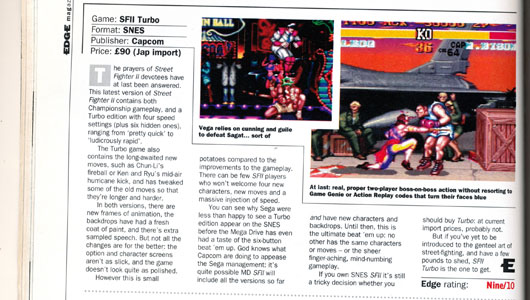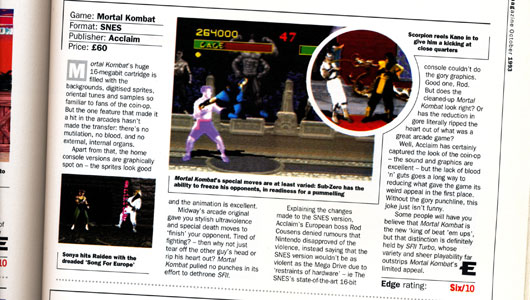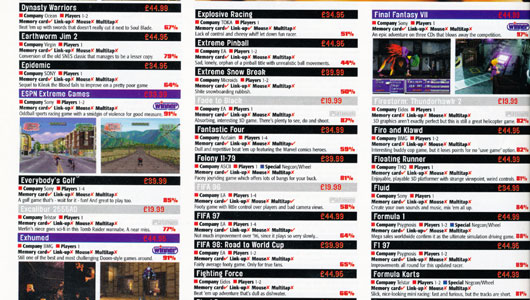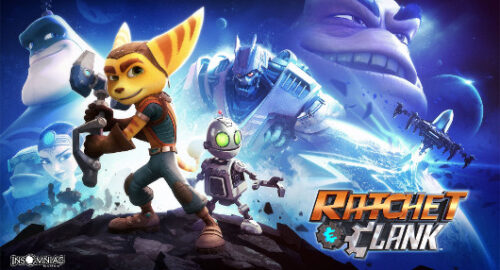Before we go any further, I need to establish a few facts. I do not want a price increase, but I am looking to prove that they are both needed and overdue. I am not a fan of paying more money for the things that I love, but I also live in the real world. No matter how fun the products they make are, I accept that a business is in business to do one thing – to make money. No matter how big or small the company is, no matter how successful they have been In the past and no matter how good they are at encouraging fan loyalty, if they do not make a profit, then they do not continue to exist. And I like the things I love to exist.
I am also not simply saying; “Hey, charge me more at retail!”, as there are a number of alternatives – many of which are already being used today. My concern here is that there is an increasing amount of sometimes seemingly ill informed resistance to– and sometimes terrible implementation of — a number of these methods and I worry that an overly negative reaction to one of these being implemented in the future will be the catalyst for developers and publishers totally abandoning these plans in favour of the lazier (and what I believe will be the more destructive) option of just simply increasing retail prices.
Also worth noting that I am looking at this more from the British perspective as I am fully aware that the price increase that was implemented in the US in recent years did not happen in the UK, but we have historically always paid comparatively higher prices anyway, and so all this really did was to bring America into parity with the UK. For the benefit of US readers, £40 is currently equal to $59.60, so equates directly to your $60 price category.
To start, let’s deal with the economic elephant in the room, inflation. Simply put, all prices increase over time as a natural function of a capitalist economy and as such, the relative value of money declines over time. So, your £40 in 1993 would have bought you a lot more pints of milk in 1993 than it would today, because the price of milk in that time has increased. By way of example, a loaf of bread cost an average of 51p in 1999, but cost an average of £1.26 by 2009 — i.e. a price increase of 147% — in the same timeframe retail game prices have not only not increased, but have generally fallen in price. Put simply, if the price of a developers sandwich has gone up and he does not charge more for his game then the increased costs have to come out of their profits. Using a straight Inflation Calculator (which estimates the decrease in the purchasing power of money as an average across a variety of common products) £40 in 1993 is the equivalent to £68 in 2012. If inflation was the only market force influencing game prices then they would now cost £68 – and that would not allow for an increase in profit, that is merely to keep the price at the same value it had in 1993.
There have been a number of “stealth increases” of game prices over the years, where profitability rose due to other factors that negated the need to increase retail prices. While this may have been good news for both publishers and consumers at the time, I believe it has made the games market unnaturally resistant to actual “normal” increases in price. To the point where, even as a reasonably minded “hardcore” gamer, I baulk at any price that dares to go a penny above the £40 magic number.
The first of these stealth increases is generally now widely known about, but at the time the amount of money saved on the production of (PlayStation) CD’s in comparison to the much more expensive cartridges of the previous Nintendo/SEGA generation, were not savings that were passed (at least not completely) onto the consumer. However there were still many occasions when, prior to this, SNES and Megadrive games were sold at a significantly higher price.

I found it difficult to find a reliable source for backing up this claim on the internet and so went to an older fountain of gaming knowledge. You see, back in the day, kiddies, we had these things called MAG-A-ZINES. They were a bit like the internet, just made out of dead trees and sold in these things we used to called SH-OPS. They were a bit like the internet, just made out of bricks and filled with real people. It was a scary time. I managed to dig out my copy of the first edition of Edge magazine from 1993 and it makes for some shocking reading. I remembered a friend of mine paying £120 to import a special edition version of Street Fighter II Turbo, so seeing that listed at £90 was not actually that surprising. Seeing a standard Megadrive (Genesis) version of Mortal Kombat listed at £60 was shocking though. For anyone complaining about the price of the WiiU at launch, then I will urge you to not to look too closely at the price of Neo Geo games — as at £225, they are nearly the same price as Ninty’s latest console!

The benefits of switching to CD to lower production costs, only lasted for a brief period of time and prices were already on the increase towards the end of the nineties. Pictured below, from PlayStation Plus Magazine in 1998: Note; Dynasty Warriors, FIFA 97 and Final Fantasy VII – all listed as £44.99. Games that have modern versions that sell at a lesser price.

The other less well discussed stealth increases (as this has arguably happened at multiple points in the history of gaming) comes from the benefits of the economies of scale. Basically summarised, the bigger your company/sales gets, the greater the savings in your costs. This is particularly relevant in videogames as the production costs of a game are more heavily weighted in the one-off, up-front cost of software development, than the variable cost of physical media production (or more recently in server/bandwidth download costs.)
The same can be said of videogame hardware, as a lot of the cost in weighted in terms of upfront research and development, but unlike software, hardware is commonly sold at a loss – that is until effects such as economies of scale come into play and help reduce manufacturing costs. It could be argued that the effect of an economy of scale kicks in whenever a console (and then following software) breaks into mainstream saturation of the market, but is most likely to have had a greatest effect with;
• The NES – a console that sold over 60 million units worldwide, a figure only bested by seven consoles since (and worth noting three of those were from Nintendo.) With the comparative failure of the Gamecube and N64, the Wii was a return to form in regards of Nintendo re-reaching the economies of scale heights in terms of hardware sales and Nintendo would also likely have financially benefited in this way with the original Game Boy.
• The PlayStation – the first console to break the 100 million mark and this arguably continued into the next generation with the PS2 breaking through 150 million units sold worldwide.
There were more consoles sold in the last generation than at any other time, but this was largely, in part, due to two factors. The Wii selling to “new” markets (and later the Kinect and Move jumping in) and that Xboxes and/or PS3’s actually gained ground in becoming the family’s all singing, all dancing living room media hub. I suspect that these forced the market into a period of over-saturation. Going forward, in a tough economic climate, without being able to see a unique selling point that is quite so marketable to the masses — as PS1’s CDs/ PS2’s DVDs/PS3’s Blu Ray or Video streaming — I do not think that the upcoming generation of hardware will sell as well as the last.
While there are other factors at play, this could be evidenced by the slow initial sales of the WiiU – which analysts widely agree will not sell as well as the Wii. Even if they do manage to match hardware sales figures it is highly unlikely that it will be any vast jump. In other words, there is very little chance that any of the main three console manufactures profits will gain any additional benefits from economies of scale with the next generation of consoles – unless Xbox or PlayStation are able to establish a significant increase in their share of the market. Although Michael Pachter recently predicted that “Xbox 720” and PS4 will increase their overall totals while selling a similar number of consoles in the next generation, but even he does not expect a massive increase. Time will tell, but the only factor that may come to the rescue is if I have underestimated the influence of emerging markets in areas outside of America, Europe and Japan.
This current, soon to be previous, generation of consoles saw the birth of a new kind of stealth price increase in software – namely Downloadable Content. This is so prevalent in modern games that we often forget about it, but it has helped games become more profitable without the need to raise prices, or at least the initial “off the shelf” price. There are still times when consumers (sometimes with good reason) will rebel against content that is seen to have been subtracted from the disc rather than an addition to the game, especially when this appears in the form of the (sometimes functionally advisable) on-disc DLC.
But most people are comfortable with the take-it-or-leave-it notion of DLC. It allows willing fans of the game to pay to broaden their experience. Badly implemented DLC is still a problem and keeping both the original disc-based customer and the prospective DLC owner happy is a delicate balancing act, that tightrope walks between adding meaningful content and making someone feel like something was missing from the original. When all those factors are correct though, there is little doubt that this is a win-win situation for consumers and developers. If you choose to add more content to your game, then you can financially compensate the developer for the extra work.

Microtransactions are the latest form of DLC that seem to be a sore point for a lot of gamers recently. As with any type of DLC, poor implementation is the problem here. I recently defended Dead Space 3 from the ****storm that surrounded their inclusion of microtransactions, because the inclusion of optional accelerators did nothing to hamper my enjoyment of the game. In fact buying any of the upgrades would have detracted from my enjoyment of the game and given me less reason to explore the environment. Just because I have no interest in paying to play this game this way, does not mean I think it should not exist – I have no problem with people who, as far as I’m concerned, have more money than sense, and use this money to subsidise keeping my game prices at £40. I do not understand those that get mad in this regard either – to me it is the equivalent of going for a walk and getting mad at the cars that overtake you. They are paying a premium to go faster, but as long as you are enjoying the walk, who cares? When it starts putting me off my stride, I will be the first to complain.
I recently deleted Candy Crush Saga from my phone as I objected to aggressive money grabbing methods that detracted from my enjoyment of the, otherwise good, game. The Simpsons: Tapped Out is a another good recent example of an enjoyable game that, thanks to overly harsh timegating, encourages mircotransactions at an unreasonable price that discourages me from spending money – while also encouraging others to spend money irresponsibly. Both are games I would more have happily paid for to get a better more enjoyable game, but the free to play with microtransactions model is popular at the moment at it combats the ever increasing issue of software piracy on iOS and Android platforms. Consumer trust is something that is easily harmed and difficult to repair. Publishers, large and small, seem to be happy to financially benefit from some of the confusion created by In App Purchases. Disregarding the moral implications of harpooning yourself a £70 IAP Whale, I worry about the long term effect of widespread harm of mainstream consumer confidence and, on a level more relevant to my concerns, worry about the harmful effect this will have on the future structure of game development.
Aside from economic influences such as inflation and economies of scale, the simple truth that we may not like having to face up to is that development costs have risen sharply in the current HD generation and are likely to be increasing as developers have to learn their way around the new hardware of the next generation. EA CFO Blake Jorgensen recently confirmed this by stating that “development cost per game could be 5-10 per cent higher on PS4 than on current generation consoles“. We are already seeing a decline in the number of mid-tier games and this is set to continue with companies having to take even greater risks on a lesser number of projects and this will likely result in a less stable market where one failure could result in massive financial catastrophic disaster, even for the larger publishers. Taking greater risks means that investors will likely demand a greater potential income – most easily bought about by higher retail prices — but further increases in development costs and pressures of inflation will make this an inevitability.
I fully expect that retail prices will rise at the start of the next generation. Overly recognised industry analyst, Michael Pachter, recently stated that he expects that prices will rise to $70 in the US and we are already seeing evidence of an increase with UK retailer Zavvi listing PS4 games priced at £69.99.
Before you start incredulously screaming “£70!?” in random people’s bemused faces and storming around the internet with reckless abandon, note two factors. Firstly the Recommend Retail Price for games is currently £49.99 and most suppliers sell at under RRP (a factor possibly already harming the games retail sector) and it is likely that Zavvi aimed high as it is easier to reduce prices later than to increase them – but it does point towards them indicating a higher price for the next generation of games. I expect that we will see games priced in the £50-60 category, but there are alternatives that I think the majority of gamers will be happy with and publishers and developers still able to afford their sandwiches.
Hideo Kojima recently suggested a scheme of producing “pilots” of games in a similar manner to the production of TV series. This to me isn’t that far removed from the highly polished slices of games currently produced for demos and may take some convincing that people will happily pay for something that they perceive they have previously received for free. Although this model does arguably have some examples of working in practise with the most prominent example being the Prologue versions of Gran Turismo.
My solution is different and I (unfortunately) have not seen anyone talking about it yet. We should get back to having a further degree of separation between single and multiplayer games. Stop forcing Multiplayer modes into single player games and stop producing a five hour campaign mode to go with your mainly Multiplayer experience. This would bring down development costs overnight and mean that the two component parts of single and multiplayer will have to stand on their own merits. You could still produce a multiplayer game where relevant and they could still be produced at a similar time with shared assets, but when it comes to retail, you could sell one part for £30-40 or get both for the bargain price of £50-60. The number of times that gamers would save money on unwanted and often unplayed game modes would also help off-set the overall price increase. It could also have the possible benefit of saving the realm of mid-tier games from disappearing entirely.
As I stated I like the things I like to continue to exist. If we don’t start paying higher prices for games in one form or another then we will have to face a future with smaller, shorter console games. And less of them. I am all for the increase in smaller “indie”games, as well as games for phones and tablets, but I don’t want that to totally replace the big budget “AAA” console titles. I want the future of games to be bigger and better with all the nice shiny graphics you can ram into my eyeholes. In a market where selling 3.5 million copies is considered a commercial failure, if we have to face up to a future where we have to pay more than £40 for a the best the industry has to offer, then maybe that is a reality we have to start waking up to before we pay an even higher price.







Daruna
I read this. Mostly pointlessly fallacious, narrow minded, deliberately misleading postulation. There are two key issues you deliberately avoid here.
The first one is that far more people now play games than did in the 90’s. So them £30 go a lot further than they used to. Secondly and more importantly, look at the abysmal way that the games industry is run. A perfect example of this is Doom 4. There is masses of room for cost reduction related to production which you know about and do not need me to list.
Poor job here sorry, you make some good points but if this was debate you would be set for a swift annihilation my good friend.
Darth Nutclench
A very good article, with some excellent points. I would be keen to see the figures showing a comparison of the cost of production/shipping of physical copies of games to the cost of bandwidth and servers required for digital titles. It seems too much of a coincidence that the price is exactly the same. I remember once talking to a Sony rep at a PS3 release party in London about downloadable content and how they were going to be releasing games much more cheaply on the console than in the shops. Apart from season sales this never really seemed to happen.
I would love to see the split SP/MP model emerging, but I can’t see it happening very soon. Most of the general public don’t know the difference, and it would make the CODs/BF3s of this world very hard to market without the Hollywood style adverts of their single player campaigns. I was so annoyed when StarHawk released a cheaper, MP only version of the game as I only bought the original for that part of the game. Perhaps once we , inevitably, sorry, Tim, go to digital only distribution you could choose your game content a bit like optional extras when buying your car, for a bulk discount, a bit like the Battlefield Premium service.
It will be interesting to see What Microsoft do on the 21st in comparison to What Sony is offering in the PS4. Lets hope they start a price war on the consoles.
daftchunk
Great article, not sure what Daruna read. Anyway I have no problem paying say, £60 for games in the near future as long as I get my money’s worth. And by this I mean DLC. Most games come with season passes now, and most of the time these cost half the price of a game when you buy it new. Why not just charge me for the WHOLE game that’s going to be released. Hell, even better, put it all on the disc and charge me more. I understand why multi-player titles roll out DLC every 8 weeks, as it keeps the game fresh but when a single player game releases extra ‘missions’ that last maybe two hours tops and charge me £8 a go I just think they’re trying to grab a bit money.
jabberwocker
The past couple of years have been the best in gaming history bar none. The big budget games will be out there if there is a market for it. There is and will continue to be. There is too much money to be had from big budget games. Gamers buy them at launch or wait till the game is at a price point they are comfortable with which is inevitable as now pretty much everything is digital. Developers will learn to adjust from their mistakes or just move on to that big LucasArts in the sky and some other develop team will jump in their place. Economics will take care of it and games will just get better and better!